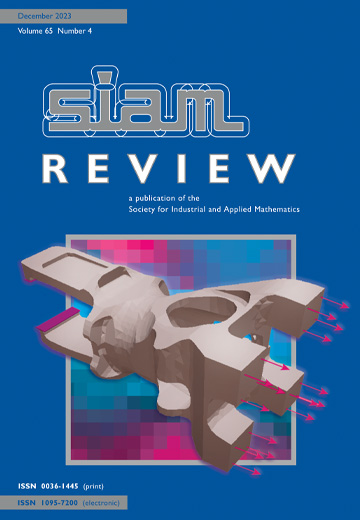Survey and Review
IF 6.1
1区 数学
Q1 MATHEMATICS, APPLIED
引用次数: 0
Abstract
SIAM Review, Volume 65, Issue 3, Page 599-599, August 2023.Apart from a short erratum, which concerns the correction of some coefficients in a differential equation in the original paper, this issue contains two Survey and Review articles. “On and Beyond Total Variation Regularization in Imaging: The Role of Space Variance,” authored by Monica Pragliola, Luca Calatroni, Alessandro Lanza, and Fiorella Sgallari, reviews total variation (TV)-type image reconstruction algorithms with a focus on Bayesian interpretations. The paper scientifically travels across various disciplines by considering a standard example problem to highlight extensions for the TV regularization model. A main contribution is a space-variant framework which allows one to describe the contents of an image at a local scale. Important applications of space-variant models are tomography, e.g., magnetic resonance imaging, electrical impedance tomography, positron emission tomography, and photoacoustic tomography, or noninvasive digital reconstruction, e.g., for ancient frescoes, illuminated manuscripts, surface colorization, etc. The unified view of many of the different models within the Bayesian framework enables one to design flexible and adaptive image regularization functionals which take advantage of the form of the underlying gradient distributions through statistical approaches. The paper contains theoretical results as well as sections on algorithmic optimization (based on the alternating direction methods of multipliers) and numerical tests for examples from image deblurring. Thus it should be interesting for researchers from several disciplines. “What Are Higher-Order Networks” is a question raised and answered by Christian Bick, Elizabeth Gross, Heather A. Harrington, and Michael T. Schaub. In short, higher-order networks are a refurbishment of graphs, removing/overcoming some of the limitations of pairwise relationships by enabling the modeling of polyadic relations in real-world systems, such as reactions in biochemical systems with several species or reagents, or interactions of multiple people in social networks. The main topics of discussion are the understanding of the “shape” of data (by identifying and classifying topological and geometrical properties of the data), the modeling of relational data via higher-order networks, and network dynamical systems (describing couplings between dynamical units). The focus of the presentation is on the mathematical aspects of the topics, but a multitude of applications are mentioned. The impressive list of references comprises 316 entries. We believe the paper to be interesting for a broad audience.
调查和审查
SIAM评论,第65卷第3期,第599-599页,2023年8月。除了一个简短的勘误表,它涉及原始论文中微分方程中某些系数的校正,本期还包含两篇综述文章。Monica Pragliola、Luca Calatroni、Alessandro Lanza和Fiorella Sgallari撰写的《成像中的总变异正则化:空间变异的作用》综述了总变异(TV)型图像重建算法,重点是贝叶斯解释。本文通过考虑一个标准示例问题,科学地跨越了各个学科,以突出电视正则化模型的扩展。一个主要贡献是一个空间变体框架,它允许人们在局部尺度上描述图像的内容。空间变异模型的重要应用是断层扫描,例如磁共振成像、电阻抗断层扫描、正电子发射断层扫描和光声断层扫描,或者非侵入性数字重建,例如古代壁画、照明手稿、表面着色等。贝叶斯框架内许多不同模型的统一视图使人们能够设计灵活和自适应的图像正则化泛函,该泛函通过统计方法利用潜在梯度分布的形式。本文包含了理论结果以及算法优化部分(基于乘法器的交替方向方法)和图像去模糊示例的数值测试。因此,对于来自多个学科的研究人员来说,这应该是有趣的。“什么是高阶网络”是Christian Bick、Elizabeth Gross、Heather a.Harrington和Michael T.Schaub提出并回答的一个问题。简言之,高阶网络是对图的翻新,通过对现实世界系统中的多元关系进行建模,消除/克服了成对关系的一些局限性,例如生物化学系统中与几个物种或试剂的反应,或社交网络中多人的交互。讨论的主要主题是理解数据的“形状”(通过识别和分类数据的拓扑和几何特性),通过高阶网络对关系数据进行建模,以及网络动力系统(描述动力单元之间的耦合)。演讲的重点是主题的数学方面,但也提到了许多应用。令人印象深刻的参考文献列表包括316个条目。我们相信这篇论文对广大读者来说是有趣的。
本文章由计算机程序翻译,如有差异,请以英文原文为准。
求助全文
约1分钟内获得全文
求助全文
来源期刊

SIAM Review
数学-应用数学
CiteScore
16.90
自引率
0.00%
发文量
50
期刊介绍:
Survey and Review feature papers that provide an integrative and current viewpoint on important topics in applied or computational mathematics and scientific computing. These papers aim to offer a comprehensive perspective on the subject matter.
Research Spotlights publish concise research papers in applied and computational mathematics that are of interest to a wide range of readers in SIAM Review. The papers in this section present innovative ideas that are clearly explained and motivated. They stand out from regular publications in specific SIAM journals due to their accessibility and potential for widespread and long-lasting influence.
 求助内容:
求助内容: 应助结果提醒方式:
应助结果提醒方式:


